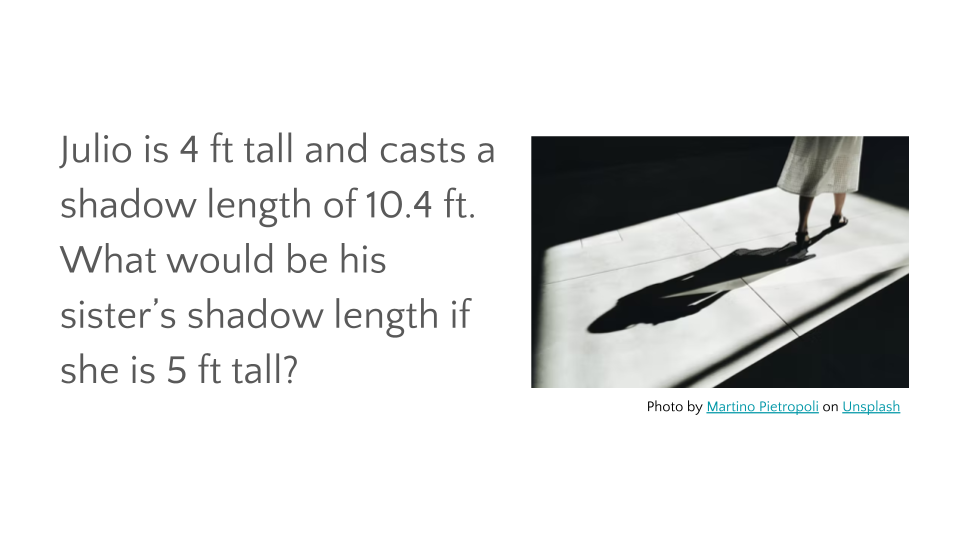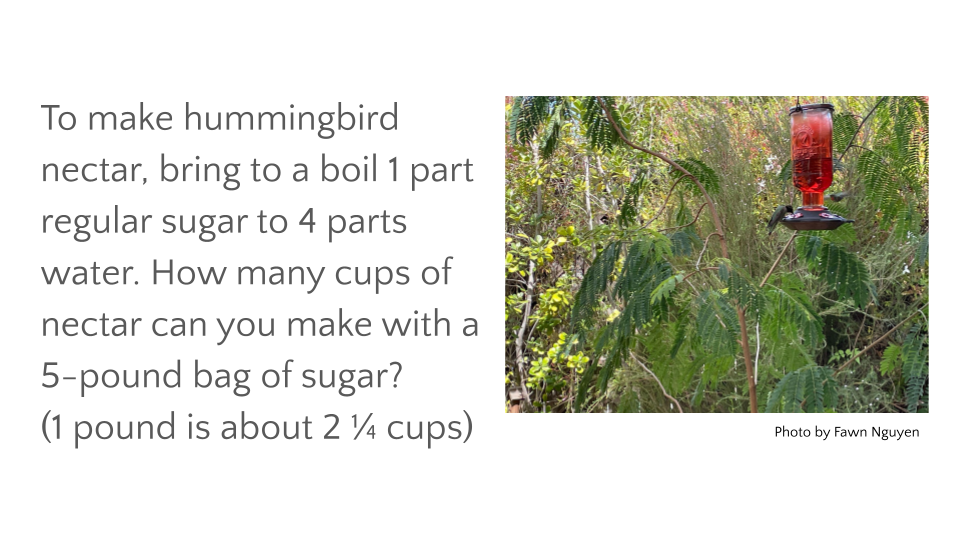My Other Math Sites
Lessons From the Classroom
Number Talks for Middle Schoolers
If I may recommend only one thing to K-12 classrooms, that thing has to be number talks. As a warm-up routine, it usually takes less than 10 minutes, yet it pays dividends in building number sense, connecting computational strategies, honoring flexible thinking.
I finally finished this set of 90 number talks for middle schoolers — enough for a full school year if you do this routine every other day. But I hope you’ll also share it with your elementary and high school teachers to inspire them to create their own or modify these.
I’ve already shared my notes about the routine on the first 4 slides. I just want to add that each slide — or each group of 3 slides — is intentional, meaning there are several strategies that I hope your students and you will explore and share. My goal is also to tweet these out, one at a time, and include people’s responses on a slide following it.
You know what you should do on the other 90 days. :)
Jelly Beans or No Jelly Beans
What's not to love about Would You Rather; I use it with my students and always recommend it as one of the great warm-up routines. This one caught my attention last week.
Each entry always includes this statement:
Whichever option you choose, justify your reasoning with mathematics.
This statement is important, especially the word "mathematics," because you might have a student who says [truthfully] that she doesn't like jelly beans or is allergic to them and will prefer to give them all away. Then, you might have another student in the same class who [untruthfully] makes the same claim to avoid having to do any maths. There's also that thoughtful student who wants to give more to his friends and keep fewer for himself. Or a student might consider giving more away to make friends. If I were to pose this question to my students, I'd mention the above possible reasonings, but then I'd add, "This question assumes that you love jelly beans and want to keep more of it for yourself. For now, it's the mathematics we're after." I didn't ask my students this question though, I asked them to choose between this question and the one on the right.
As a student, would you rather be given the problem on the LEFT (jelly beans) or the one on the RIGHT?
Using the same image above, I asked on Twitter and of my colleagues.
As a teacher, would you give your students the problem on the LEFT (jelly beans) or the one on the RIGHT?
*****
Out of my 68 sixth graders, 71% of them chose the left problem. The words they used for their reasoning:
colorful, vivid imagination, visual, more pleasant to the eyes, interesting, engaging, not boring, not basic, better reason because you like jelly beans
My fellow educators, meanwhile, overwhelmingly chose the left problem — of the 781 people who took the survey, a whopping 90% chose the left problem.
Well, I prefer the one on the right that I’d typed up. How did I get it so wrong? I'm normally not this lame. But, truth be told, I don't love the jelly beans question. At all. Maybe the one on the right is the wrong "fix" for the left one. If I could retype the problem on the right, I'd remove the equal signs since the question is just asking which one yields a larger difference, not caring exactly what each difference is.
I want to believe that anyone who spends 5 minutes with me learns that I love mathematics. I love numbers, I love math problems and don't give two shits if they are real-world either. I'm the one who loves the problem about carrying 3,000 bananas across the desert and the one about the emperor pouring oats on every other guest's head. One of my 247 all-time favorite problems is Noah's Ark, even if I grew up in a house with a Bible in every corner and found it hard to wrap my head around this story. (However, Eddie Izzard's take on the Ark — language caution — makes me laugh.) I love problems that are simply stated, yet they beg you to savor your perseverance as you think deeply and creatively. There's great joy in solving a good problem, especially the ones that at first blush, you weren't even sure how to begin.
The jelly beans problem above is not one of these problem-solving tasks. It asks for a mathematical justification, so I'm going to assume that the mathematics is finding the difference or another arithmetic operation. I see it as a number talks problem. Students get to share their strategies. Mine might include:
364 minus 188... I'd need 12 more to go from 188 to 200, then 164 more to get to 364, so the difference is 176. Similarly, to do 281 minus 137, I'd need 63 more and 81 more, or 144. Problem A has a bigger difference of 176. Comparing the two totals, 364 and 281, the difference is 19 plus 64, or 83. While the difference between the give-away quantities 188 and 137 is 51. I start out with 83 more in problem A, but I only have to give away 51 more, so problem A leaves me with more to keep.
That's why I prefer the one on the right. Numbers are beautiful. I want students to focus on the numbers and play with them, learn to regroup, try massaging them and making them flexible, be comfortable with numbers. Math is badass, so let's do maths for maths' sake. I feel protective of numbers and don't see why they need to be dressed up in colors or dunked in forced contexts. (I suddenly think of little dogs in ridiculous outfits that I doubt if anyone asked for the dogs' permission.)
Nine out of ten of you disagreed with me. That's okay because I can make phở better anybody. But guess what though? My own 23 and 25-year-old kids chose the one on the right. This fact was comforting! Sabrina (23):
If you were one of the survey respondents, I thank you thank you thank you.





